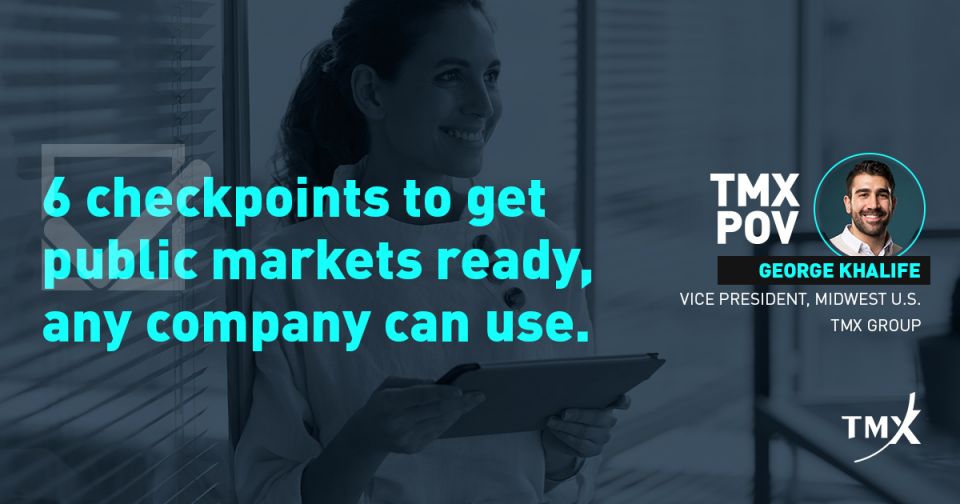TMX POV - 6 checkpoints to get public markets ready, any company can use

Having the end in sight and working backwards
Going public requires endurance. When I was on the M&A side, I'd often joke that the two exit paths are analogous to a founder running on a treadmill who has three options to select from; i) continue running at the same or higher pace, gradually cool down and come to a full stop, or crank up the speed at a very high incline and see how far you can go.
Going public and staying public is definitely not easy. In 2019, I had drinks with the CEO of a publicly traded company on TSX Venture Exchange (TSXV) and I asked him what every executive should think about before going public. His response? Every CEO should believe without an ounce of doubt that they can get their business passed $100M+ in valuation (with the sights of hitting the billion mark). If you have that kind of vision, then going public is worth the effort.
Public companies set out to "make a dent in the universe" as Steve Jobs would put it. That's not to say private companies don't, but most of the world-class innovative companies you and I know access public markets to accelerate growth while their founders aim to retain some level of control on the company's destiny.
What's needed before hand…the fun part (please keep in mind that the following pertains more to the Canadian public markets which often sees earlier-stage companies going public relative to U.S. markets):
Public market investors want to see some revenues (C$1M+ to start). Pre-revenue companies can list, but very situational and need a plan to show post-revenues within 2 years. Rate of revenue growth is heavily looked at, a good guidepost for tech companies is greater than 30%.
Public market investors want to see some revenues (ideally). Companies with no revenues can still go public but it is situational to their vertical/space (i.e. mining, life sciences, or newer emerging sectors) and also contingent on their ability to demonstrate attaining post revenues within the next two years.
For the most part, investors want to see at least $1M in revenue (for companies considering TSXV), and look heavily at the rate of revenue growth (which usually gets factored into the valuation at time of listing). In a McKinsey report, they found that "changes in top-line growth deliver twice the valuation gain that margin improvements make." Adequate working capital to carry on the business is important, and for earlier-stage companies looking at TSXV, a minimum of C$100K-$200K of unallocated financial resources to carry out the business plan is required. Investors want to also see a clear path to near-term profitability - a focus on earnings growth in the forecast will be looked at when analyzing the company's trajectory.
Public investors don't want a one-hit wonder. They want to see multiple products (ideally), a strong product-market fit, and the ability to expand into new verticals, features, and geographies. Should display attractive unit economies & healthy margins over the long haul.
Even if the company is doing well in one market, over time, investors want to see that new products can be adopted, new features added, and new geographies expanded into. The ability to scale not just revenues, but also products and services gives companies the ability to increase market share and corner competitors (all of which make the case to invest even more compelling). The ability to demonstrate a breakdown of the unit economics will also be scrutinized i.e. how are revenues realized (monthly, yearly, subscription, SaaS, etc.), how much of current revenues are recurring, what is the cost associated with that revenue, what is the revenue composition per product or service, has the product/service demonstrated viability over an adequate period or is performance volatile...you get the point.
The size of the total addressable market and industry are important in obtaining interest from investors. A larger market enables higher growth rates and an attractive industry (i.e. Telehealth in a COVID environment) will provide more financing options & attractive valuations.
Clearly, public investors prefer to invest in companies that have a large market opportunity — they're looking for evidence of wide-open, huge, total addressable markets (TAM). A large TAM means that the company could reasonably become a large franchise even without extremely high penetration of that market. Larger market size also enables higher long-term growth rates.
Senior management needs to have credible past & deep experience in the industry. Don't need public market experience (but certainly favourable to have) - can be complemented by independent directors on board. Have they managed the business well? (financials, growth, story).
Similar to when raising private rounds of capital regardless at what stage, the emphasis on team background, experience, fit, etc. are going to be heavily weighed. With respect to going public, the CEO and CFO in particular will need to have experience that reassures investors of their ability to steer the business towards success, to gain a reputation as trustworthy stewards of capital, able to competently steer the business towards success.
This is not to say that all startup CEOs and CFOs need to have several successful exits or extensive public market experience, but it is important for the senior management team to have deep experience in the industry they're serving and a credible past of having managed the business well to date (via historical financials, market share growth, ability to articulate the vision, etc.). Ultimately, reputation as being good stewards of capital is what matters here, the rest can be complemented by adding pieces to the team's missing gaps - like seasoned independent directors on the board.
The company story is the company strategy. Founders need to answer why they're looking to go public (acquisition currency, profile, growth capital, liquidity), and articulate the long-term vision clearly. The public needs to understand where you are and where you're heading.
Ben Horowitz, Co-founder of Andreesen-Horowitz and author of The Hard Thing About Hard Things talks about this at length saying "storytelling is the most underrated skill in entrepreneurship and companies that don't have a clearly articulated story don't have a clear and well thought-out strategy. The company story is the company strategy."
Some things to think about as it relates to accessing public markets are; why are we doing this in the first place? You don't want to be the company that is unsuccessful in raising capital in the U.S. and using Canadian capital markets as a last resort. What do we gain from doing this? Having thoughtful reasons as to why you're looking to go public is crucial; having currency to make acquisitions, gaining profile/awareness, raising less-dilutive capital, etc. are some to consider. What is the growth story that will be compelling to public markets investors? Although obtaining liquidity is certainly a feature of being public, it is not recommended for it to be the primary reason of wanting to go public in the first place (what's in it for investors if your primary reason is to just take chips off the table?).
If you fail to plan, you plan to fail; getting your house in order before going public is critical. Allocate enough time to select the right team of advisors, have the right corporate structure & board in place, organize financial statements, and meet auditing requirements.
Governance, readiness & preparation: This seems like the least fun part, and while that's probably accurate, it's also a very, very important phase (whether in preparing to go public, or to raise a large later-stage private round). Focusing on the going public process, there are several considerations to take into account beforehand, in particular; the process of selecting the right advisors, evaluating your corporate structure and organizing your financial statements as early as practical.
On the advisory side, an adequate team will include: a financial advisor and/or underwriter, an external auditor, a securities lawyer, investor relations professional, and in some circumstances a sponsor. Only persons registered in Canada to sell securities may legally underwrite offerings in Canada i.e. investment bankers will act as the underwriter to sell securities during the process. Talking to bankers beforehand is important to gauge interest, determine the proper valuation, and discuss timeline/steps. Securities lawyers will ensure all the listing documents are accurate and meet regulatory requirements. An external auditor will help perform important tasks like reviews on financial disclosure in the listing documents and auditing financial statements. Investor relations professionals increase public awareness of the company through communication initiatives directed at existing and prospective shareholders. For all advisors, it's important to choose a firm with extensive experience in listing public companies of a comparable size in a similar industry.
Furthermore, the composition of your management team and board of directors should include: individuals with experience relevant to your business, individuals with relevant public company experience, individuals familiar with Canadian securities laws, and at least two independent directors on the board. You'll also have to get your financial statements audited (usually two to three years) and keep up with the reporting requirements of being a publicly-listed company i.e. annual and quarterly reports as well as disclosures on material information or changes.
In conclusion…when it comes time to prepare for any growth-related milestones, a checklist like this is about more than just having good hygiene — it's really about adopting a disciplined approach to building a healthy, sustainable business. Regardless of the financing path, these are all things founders should be actively thinking about and working towards: paying attention to financials, thinking through product evolution, ensuring strong internal governance, building company culture, etc.
Everyone wants to invest in a company that's built to last.
George Khalife
VP Capital Formation (Midwest U.S.),Toronto Stock Exchange and TSX Venture Exchange
george.khalife@tmx.com
Follow George on LinkedIn
Copyright © 2020 TSX Inc. All rights reserved. Do not copy, distribute, sell or modify this document without TSX Inc.'s prior written consent. This information is provided for information purposes only. Neither TMX Group Limited nor any of its affiliated companies guarantees the completeness of the information contained in this publication, and we are not responsible for any errors or omissions in or your use of, or reliance on, the information. This publication is not intended to provide legal, accounting, tax, investment, financial or other advice and should not be relied upon for such advice. The information provided is not an invitation to purchase securities listed on Toronto Stock Exchange and/or TSX Venture Exchange. TMX, the TMX design, The Future is Yours to See., Toronto Stock Exchange, TSX, TSX Venture Exchange, TSXV, and Voir le futur. Réaliser l'avenir. Are the trademarks of TSX Inc. All other trademarks used herein are the property of their respective owners.


